Table of Contents
- Understanding Baby Bird Development: From Egg to Fledgling
- Essential Tips for Identifying Common Baby Birds
- The Truth About Feeding and Nurturing Baby Birds
- Baby Birds: Behavior Patterns and Communication
- When and How to Help Fallen Nestlings
- Natural Survival Mechanisms of Baby Birds
- Creating a Safe Environment for Orphaned Baby Birds
- Common Myths and Misconceptions About Baby Bird Care
- Conclusion
- FAQ
Ever wondered about the secrets of baby birds? These small, delicate creatures have a world full of mysteries. Their growth, adaptation, and survival are truly captivating.
Learning about baby birds is more than just curiosity. They show amazing resilience and survival skills from the start. Tips for caring for baby birds reveal their development, behavior, and special traits.
From the first moments of life to becoming independent, baby birds go through incredible changes. This article will explore their world. We’ll look at how to identify them and the survival strategies they use.
Key Takeaways
- Baby birds undergo rapid and complex developmental stages
- Proper identification helps in understanding different species
- Specialized care is crucial for baby bird survival
- Each bird species has unique growth and nurturing requirements
- Understanding their behaviors can help protect and support them
Understanding Baby Bird Development: From Egg to Fledgling
Baby bird development is a fascinating journey that captures the hearts of many. It’s a transformation from egg to fledgling, filled with important milestones and fast growth.
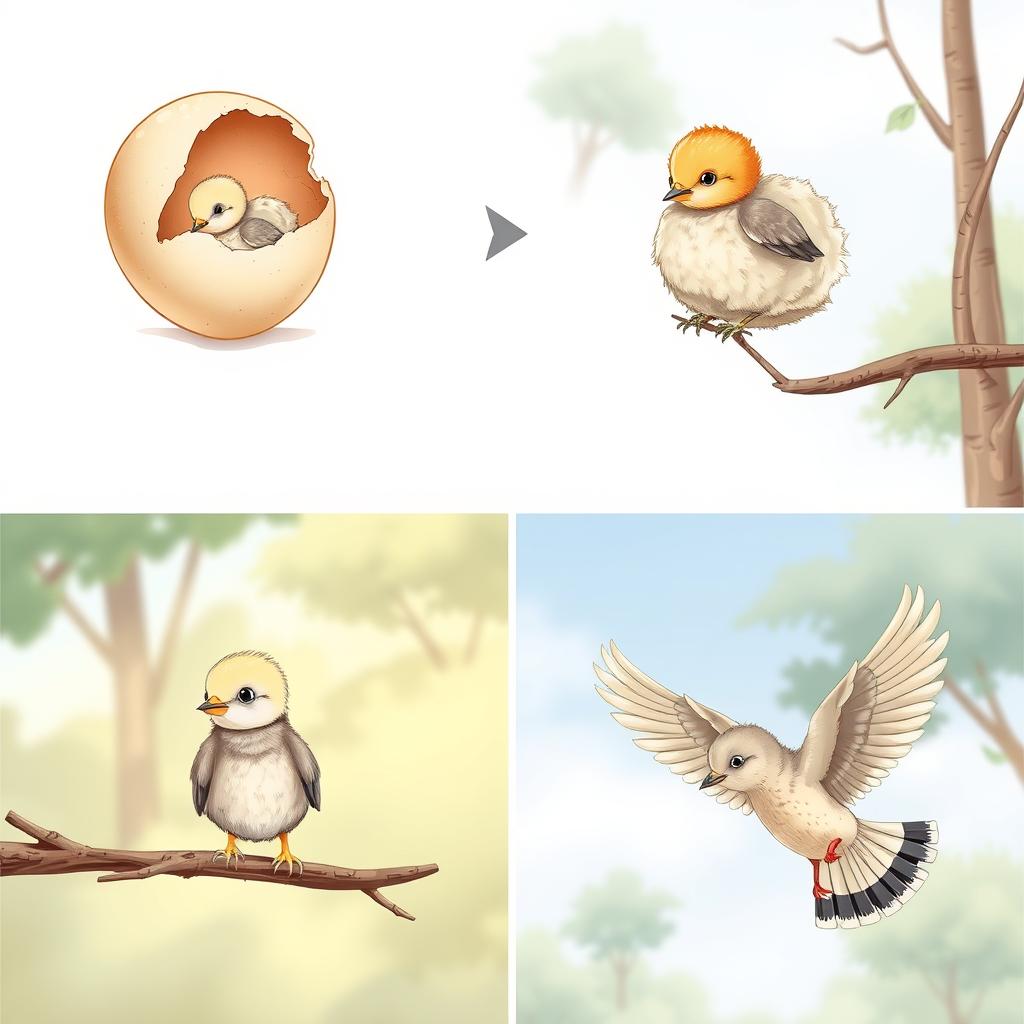
Watching baby birds grow helps us appreciate the amazing process of avian development. Each bird species has its own path, but some common patterns are seen across many.
Key Milestones in Baby Bird Growth
- Hatching: Breaking through the protective eggshell
- Feather emergence: First downy coat appears
- Eye opening: Gaining visual perception
- Wing development: Preparing for first flight
Physical Changes During Development
Signs of a healthy baby bird include steady growth, active movement, and physical changes. The growth sequence usually includes:
- Naked and helpless nestling phase
- Gradual feather growth
- Muscle and skeletal strengthening
- Increased independence
| Growth Stage | Physical Characteristics | Duration |
|---|---|---|
| Hatchling | Pink, naked, eyes closed | 0-7 days |
| Nestling | Downy feathers, growing rapidly | 7-14 days |
| Fledgling | Feathered, learning to fly | 14-21 days |
“Nature’s most beautiful symphony is the growth of a baby bird” – Ornithology Research Institute
Each baby bird’s journey is unique, showing the incredible diversity of avian life and their amazing adaptability.
Essential Tips for Identifying Common Baby Birds
Identifying baby bird species is both challenging and fascinating. It requires keen observation and specific knowledge about different species’ unique characteristics.

Baby birds often look very different from adults. This makes a baby bird identification guide very important. Young birds have distinct features that help identify their species.
- Observe beak shape and size
- Note feather coloration and texture
- Watch body proportions
- Listen to distinctive chirping patterns
Here are key identification strategies for common backyard baby birds:
| Bird Species | Unique Identification Markers | Age Indicators |
|---|---|---|
| Robin Nestlings | Sparse, gray downy feathers | Pink skin visible, closed eyes |
| Sparrow Fledglings | Mottled brown feather pattern | Partially developed wing feathers |
| Finch Chicks | Soft, fluffy initial plumage | Shorter tail feathers |
“Patience and careful observation are the keys to successful bird species identification.” – Ornithology Expert
When identifying baby bird species, remember to keep a respectful distance. Never disturb active nests or handle young birds without professional guidance. Each species has unique developmental stages that require specialized understanding.
Developing your skills in baby bird identification takes time and practice. Carry a reliable field guide, use binoculars, and document your observations to improve your expertise.
The Truth About Feeding and Nurturing Baby Birds
Feeding baby birds needs special knowledge and careful attention. Knowing the right baby bird care tips can greatly help their survival and growth. It’s very important to give them the right food during their most vulnerable times.
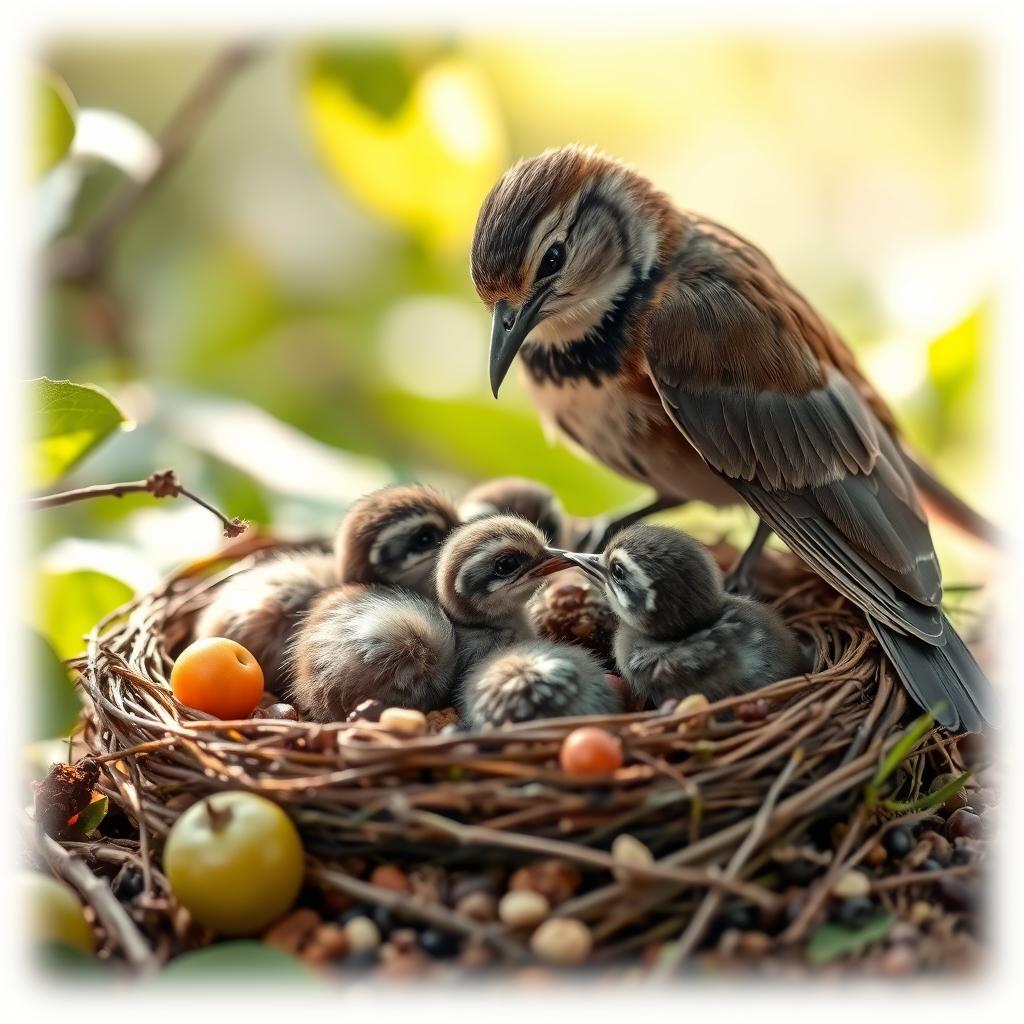
To feed baby birds well, you must know their special food needs. Each bird species has its own nutritional needs. Meeting these needs is key for their healthy growth.
Safe Foods for Different Species
Choosing the right food for baby birds is crucial. Not all foods are good for every bird species.
- Songbirds: Insects, worms, and special protein-rich diets
- Raptors: Small pieces of raw meat
- Waterfowl: Commercial waterfowl starter feed
- Seed-eating birds: Soft seeds, commercial nestling food
Feeding Schedules and Techniques
Following the right baby bird feeding guidelines is important. You need to know their age and species-specific needs.
| Bird Age | Feeding Frequency | Recommended Technique |
|---|---|---|
| 0-1 week | Every 15-20 minutes | Dropper or specialized syringe |
| 1-2 weeks | Every 30-45 minutes | Soft-tipped feeding implement |
| 2-3 weeks | Every 1-2 hours | Graduated feeding techniques |
Common Feeding Mistakes to Avoid
Many people mean well but accidentally harm baby birds with wrong feeding methods.
“The most critical aspect of baby bird care is understanding that each species requires unique nutritional support.”
- Never feed cow’s milk or bread
- Avoid force-feeding
- Do not provide water directly
- Maintain proper temperature during feeding
If you’re unsure about what to feed, it’s best to ask wildlife experts. They can help ensure the baby birds survive.
Baby Birds: Behavior Patterns and Communication
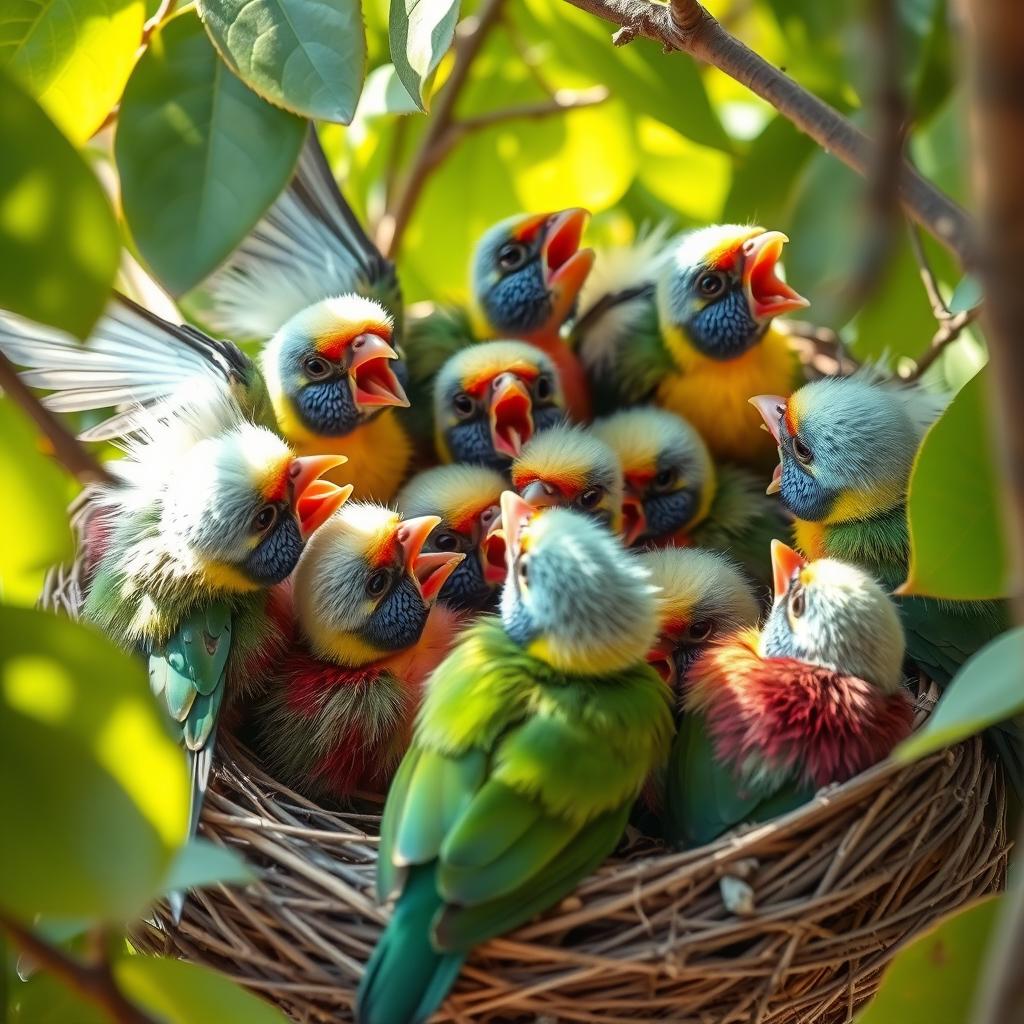
Baby bird behavior is truly fascinating. They learn to communicate and survive from a young age. They develop complex social skills, using various methods to interact with their family and environment.
Baby birds communicate in several ways:
- Vocal signals like chirping and peeping
- Physical movements and postures
- Begging behaviors for food
- Visual cues to attract parental attention
Nestling communication is especially complex. Baby bird care tips show that young birds use different sounds to signal needs. High-pitched, rapid chirps usually mean they’re hungry. Softer sounds might show they’re feeling comfortable or happy.
“Every chirp tells a story of survival and connection in the avian world.” – Wildlife Ornithologist
Sibling interactions are key to understanding baby bird behavior. Nestlings often compete for food and learn survival skills from each other. They also develop a hierarchy and learn important social behaviors.
As they grow, young birds learn more complex communication. They start to mimic their parents’ sounds and recognize family members. They also develop social behaviors that help them when they’re on their own.
Watching these complex communication patterns helps us understand baby birds better. It shows us their amazing survival strategies and social behaviors.
When and How to Help Fallen Nestlings
Finding a fallen baby bird can upset many people. It’s important to know how to help them gently. Not every nestling needs our help, and sometimes the best thing is to do nothing.
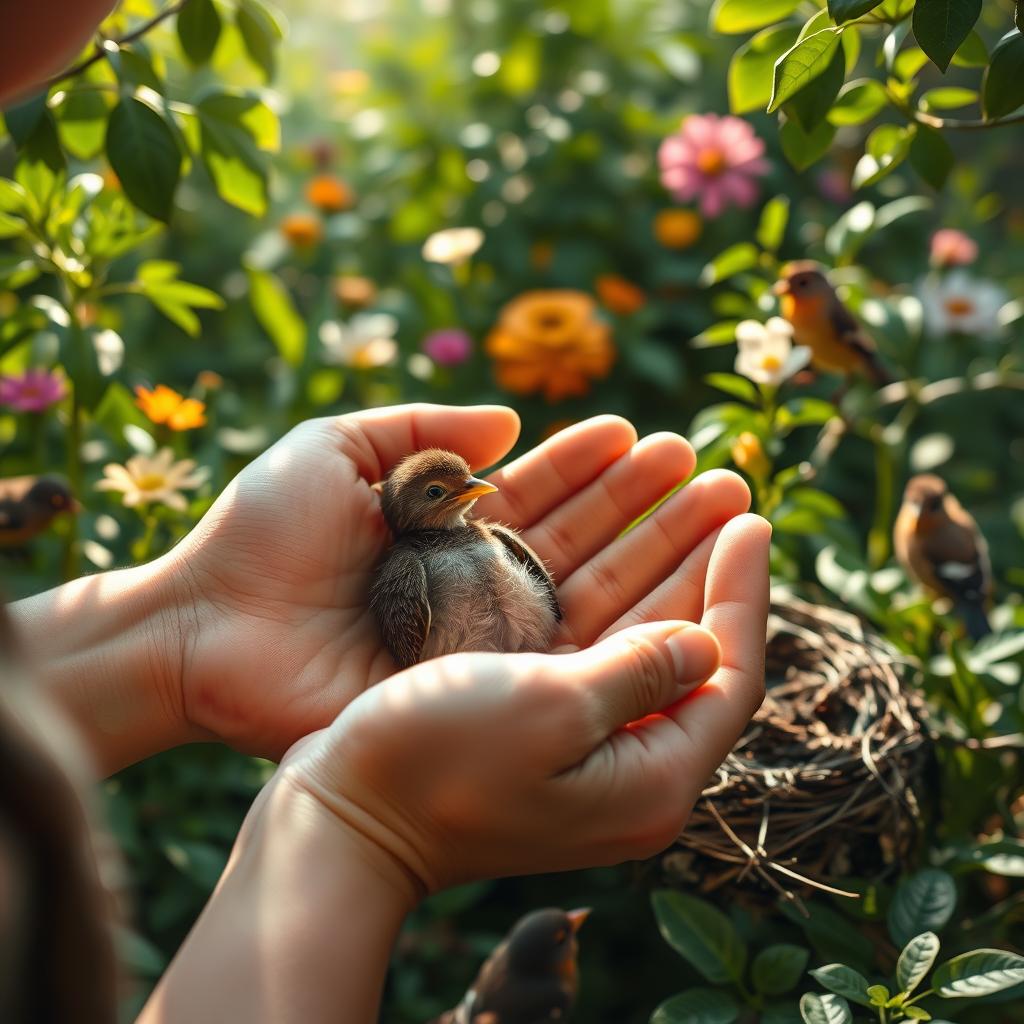
Before you try to save a fallen nestling, think carefully about it. Different baby birds need different kinds of help.
Emergency Care Guidelines
- Check if the bird is a nestling (no feathers) or fledgling (feathered)
- Determine if the bird is injured or in immediate danger
- Observe from a distance to see if parent birds are nearby
Signs That Indicate Professional Help is Needed
- Visible physical injuries
- Obvious illness or weakness
- No parental activity for several hours
- Bird appears extremely young or vulnerable
Safe Handling Practices
When you rescue a baby bird, follow these important steps:
“The key is minimal intervention and maximum care.” – Wildlife Rescue Expert
- Wear protective gloves
- Use a soft cloth or tissue to handle the bird
- Keep the bird warm and quiet
- Contact local wildlife rehabilitation centers immediately
Most baby birds do better with their parents. Always try to reunite the nestling with its family first. Only then should you consider helping them yourself.
Natural Survival Mechanisms of Baby Birds
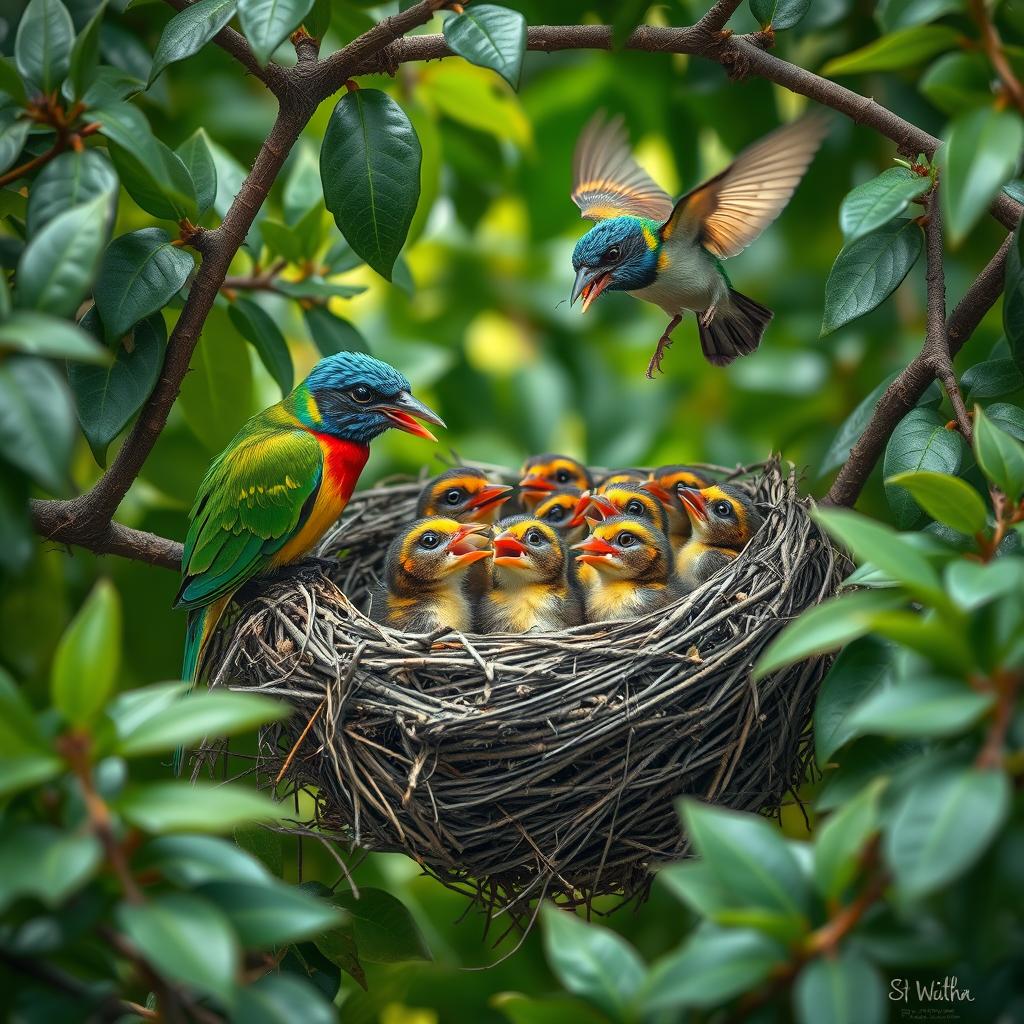
Baby birds have amazing ways to survive in the world. They have special behaviors that help them stay safe in tough places.
“Nature has equipped baby birds with incredible instincts that protect them from potential threats.” – Ornithology Research Journal
These young birds have clever ways to protect themselves. Their secrets include:
- Camouflage Techniques: Baby birds can blend in with their surroundings, making it hard for predators to find them
- Rapid Growth Rates: They grow fast to get stronger and more independent quickly
- Vocal Communication: They use unique sounds to talk to their parents and warn of dangers
- Instinctive Hiding Behaviors: They stay still and quiet when they sense danger
The survival ways of baby birds show how amazing nature is. They can recognize their parents’ calls, notice changes in their environment, and learn to protect themselves. This shows nature’s incredible design.
| Survival Mechanism | Purpose | Effectiveness |
|---|---|---|
| Camouflage | Predator Avoidance | High |
| Vocal Recognition | Parental Connection | Critical |
| Quick Growth | Independence | Essential |
Baby bird survival secrets show a complex mix of biology and behavior. These young birds are incredibly resilient. They understand the challenges of their environment in a way that’s truly remarkable.
Creating a Safe Environment for Orphaned Baby Birds
Rescuing baby birds needs careful planning and special care. Experts say that helping birds at home requires a lot of knowledge. To care for baby birds well, you must create a safe, caring space that feels like their home.
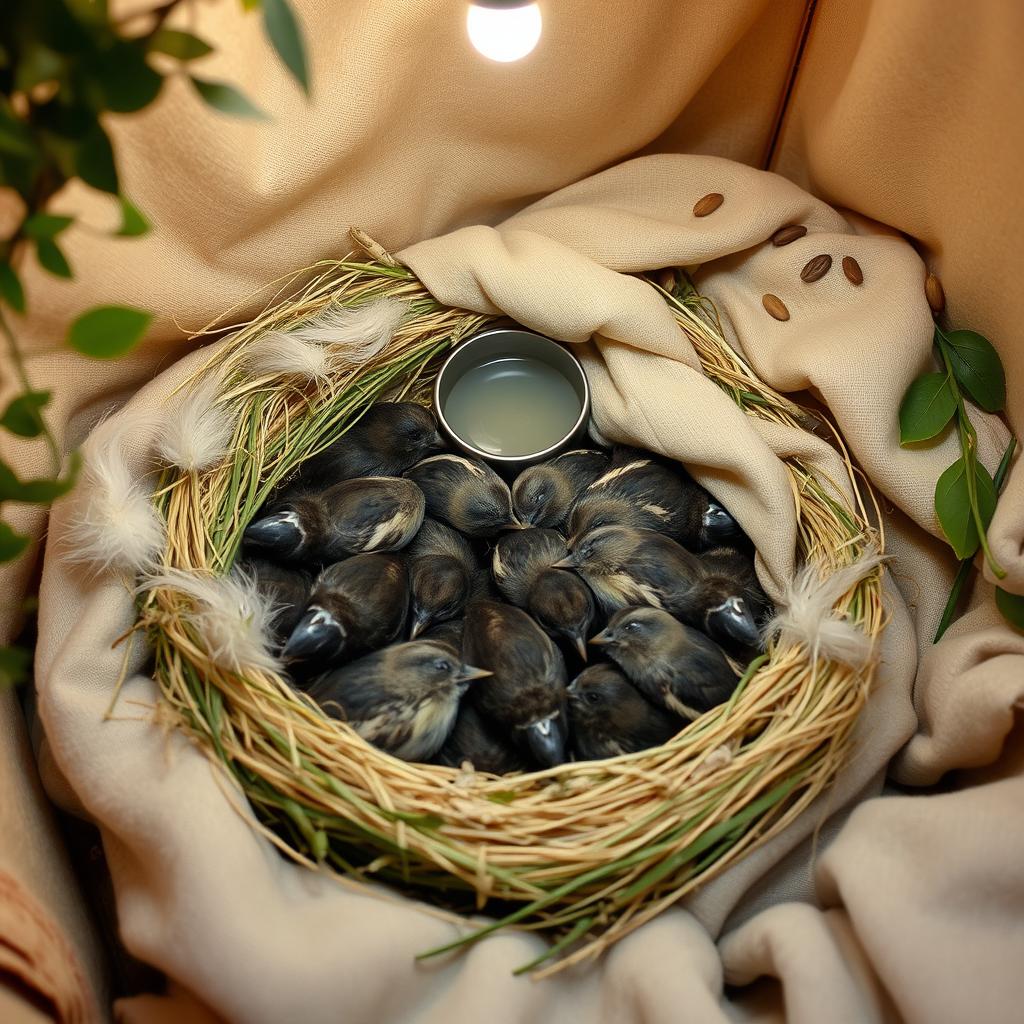
When caring for nestlings, it’s important to know what they need. Getting help from a pro is key during the rescue and care process.
Temperature and Housing Requirements
Keeping the right temperature is key for baby birds’ survival. They can’t keep themselves warm and need constant heat.
- Use a heating pad set on low underneath a towel-lined container
- Maintain ambient temperature between 85-90°F for newborn birds
- Gradually reduce temperature as feathers develop
- Ensure draft-free environment
Essential Supplies Checklist
| Supply Category | Recommended Items |
|---|---|
| Housing | Ventilated cardboard box, soft towels, heating pad |
| Feeding | Specialized syringes, soft tweezers, species-appropriate formula |
| Hygiene | Disposable gloves, disinfectant, clean cloths |
Monitoring Health and Progress
Watching how a baby bird grows is important. It’s important to handle them as little as possible to avoid stress and imprinting.
- Check weight daily
- Observe feather growth
- Monitor feeding response
- Watch for signs of distress
“The goal of rescuing orphaned baby birds is always safe rehabilitation and eventual return to their natural habitat.” – Wildlife Rehabilitation Association
Remember, rescuing baby birds is a big job. Working with a wildlife expert is the best way to help them recover and return to the wild.
Common Myths and Misconceptions About Baby Bird Care
When it comes to baby bird care, it’s important to know what’s true and what’s not. Many people mean well but spread false information that can hurt baby birds. It’s key to know the right way to care for them.
“Not everything you hear about baby birds is true. Knowledge is the best protection for these vulnerable creatures.” – Wildlife Rehabilitation Expert
Now, let’s look at some common myths about feeding baby birds and wildlife care:
- Myth: Touching a baby bird will cause parents to abandon it Reality: Bird parents don’t usually reject their young because of human touch. It’s best to keep nestling care minimal and thoughtful.
- Myth: All fallen baby birds need immediate rescue Fledglings often spend time on the ground while learning to fly. Not every bird needs help from humans. It’s wise to watch before acting.
- Myth: Bread is a suitable food for baby birds Bread is not good for baby birds because it lacks nutrients. They need food that’s right for their species.
Wildlife experts stress the need for professional advice in caring for baby birds. False beliefs can do more harm than good.
Here are some essential tips for baby bird care:
- Always check with wildlife experts before helping
- Learn what each species needs
- Keep human contact to a minimum
- Feed them the right food
By clearing up these myths, we can make a safer place for young birds to grow and thrive.
Conclusion
Learning about baby bird care needs patience, respect, and a love for wildlife. Our exploration into their world shows how amazing and complex birds are. From their first days to their first flights, baby birds are a true marvel of nature.
Studying baby bird behavior teaches us a lot about nature’s balance. Experts say we should watch from a distance and not interfere too much. Each bird has special ways to survive, showing how important it is to appreciate them from afar.
The key to caring for baby birds is to live in harmony with nature. Local Audubon chapters suggest helping conservation, protecting habitats, and teaching others about birds’ importance. By being aware and caring, we help birds thrive for generations to come.
Thinking about baby birds reminds us of our connection to all living things. Their survival is a symbol of hope, adaptation, and the magic of nature. Every effort we make to protect them helps our planet and future.
FAQ
How can I identify a baby bird’s species?
To identify a baby bird, look at its beak shape, body size, and feather color. Check for any unique markings. Use local bird guides or bird apps for help.
Also, consider the bird’s habitat and where you found it. These clues can help figure out its species.
What should I do if I find a baby bird on the ground?
First, check if the bird is a nestling or a fledgling. Nestlings are featherless or have few feathers. Fledglings are fully feathered.
If it’s a nestling, try to put it back in its nest. For fledglings, it’s best to leave them alone. They’re learning to fly.
If the bird looks injured or is in danger, call a local wildlife center for help.
What do baby birds eat?
Baby birds eat insects, worms, and food from their parents. Never give them bread, milk, or human food. If you must care for a bird, use special baby bird formula.
Each bird species has different food needs. Always get advice from wildlife experts.
How often do baby birds need to be fed?
Baby birds in the wild eat often, every 15-20 minutes. Nestlings need more food than fledglings. If you’re caring for an orphaned bird, feeding times depend on its age and species.
How can I tell if a baby bird is healthy?
A healthy baby bird moves well, has bright eyes, and eats regularly. It should grow steadily and have clean feathers. Look for weight gain and alert behavior.
Signs of illness include being very tired, visible injuries, or not wanting to eat.
Can I keep a baby bird as a pet?
No, it’s illegal in most places to keep wild birds as pets. They are protected by laws. The best thing is to help the bird go back to nature.
If a bird needs help, contact a licensed wildlife rehabilitator. They can care for it and release it back into the wild.
How long do baby birds stay in the nest?
Nest time varies by species. Some birds leave the nest in 10-14 days, while others stay for 3-4 weeks. The bird’s species, environment, and food availability affect this.
Fledglings leave the nest when they can fly. But they still need their parents for food.
What temperature do baby birds need?
Baby birds need warmth, about 95-100°F (35-38°C), when young. As they grow, they can handle slightly cooler temperatures. If caring for an orphaned bird, use a heating pad or a bird brooder to keep it warm.
How do baby birds learn to fly?
Baby birds learn to fly by practicing. They start by fluttering between branches. They build strength and coordination this way.
Parent birds help by showing them how to fly and feeding them at longer distances. This encourages the young birds to practice.
What are the biggest threats to baby birds?
Big threats include predators like cats and hawks, extreme weather, and lack of food. Habitat destruction and human actions also harm them.
Nest location, parental care, and the bird’s ability to hide and be quiet are key to survival.
